Netflix reports earnings after the close. The expected move from the options market is about 5.5%, or about $29 in either direction. Recent earnings have seen moves of -7%, +16% and -7%, via the Options AI Earnings Calendar:
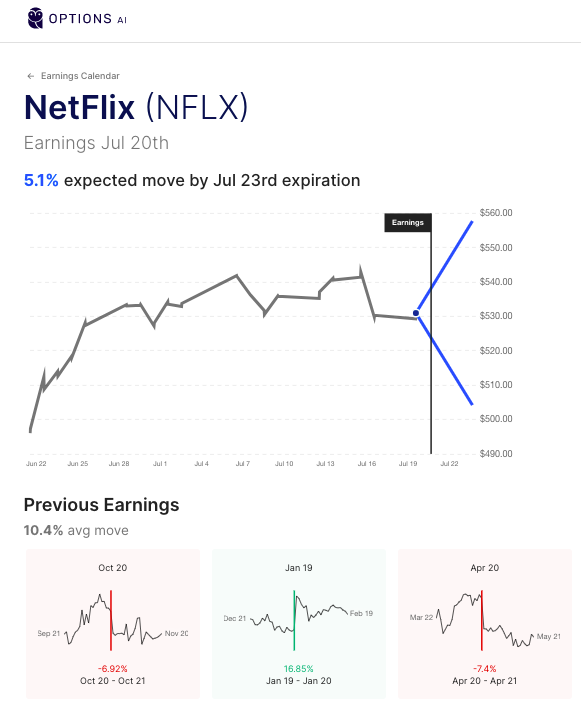
Whether looking to buy outrights Calls or Puts, or to reduce capital outlay through Spreads, the expected move can be a valuable tool in both strategy and strike selection. Below, we’ll look at several trades that incorporate the expected move, using Netflix earnings and options expiring this Friday to illustrate.
Debit Spreads
For instance, a Call Spread to the expected move might be used by a trader positioning for a stock move in line with options market expectations. Buying higher probability at or near-the-money Calls while simultaneously selling lower probability Calls at or beyond the expected move.
Here’s an example: a +535/-565 Debit Call Spread with NFLX trading around $535. It costs around $10, and can make up to $20 if the stock is at or above $565 on Friday. It buys the $535 call for around $15, while simultaneously selling a $5 call at the expected move, for a net debit of $10.
That’s less expensive than buying the 535 Call outright, along with higher probability of profit (based on its breakeven of $545). Here’s how the trade looks on an Options AI stock chart. The breakeven is indicated by the grey line, the risk / reward ratio by the red and green areas:
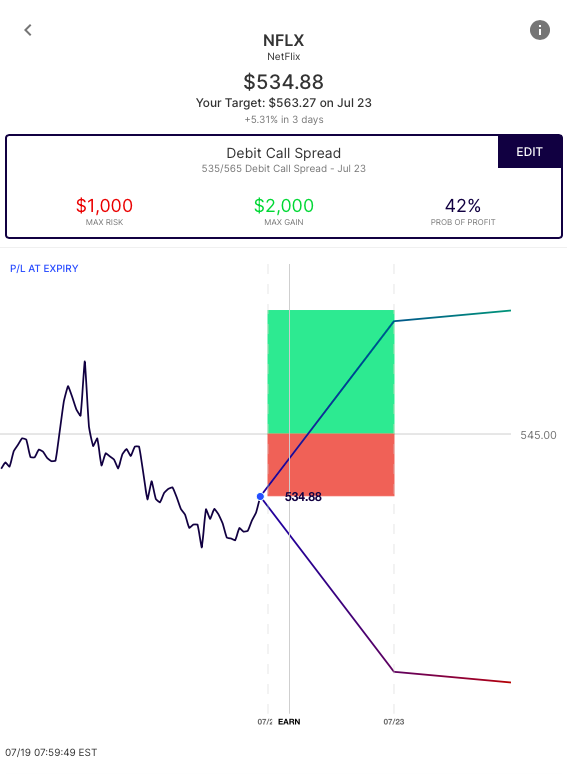
Here is the bearish version of a Debit Spread to the expected move, a +535/-507.5 Debit Put Spread. The breakeven on this trade is near $524 in the stock. It is profitable below that level and would achieve its max gain if the stock is at or below $507.50 on Friday:
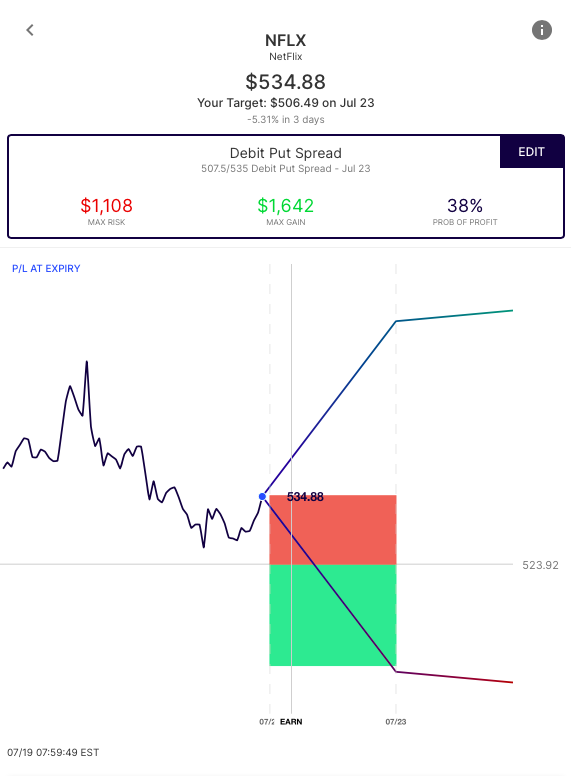
Credit Spreads
Debit Spreads are a way to reduce premium at risk while positioning for directional moves. However, they still require a move beyond the trade’s break-even level to be profitable at expiry. Credit Spreads do the opposite, positioning against a directional move.
An easy way to understand Credit Spreads is that you are simply taking the other side of a Debit Spread.
For example, here’s the NFLX -535/+507.5 Credit Put Spread. It is bullish by not being bearish. You’ll notice it’s the same trade as the Debit Put Spread above, however, the trader is a seller of the spread, not a buyer:
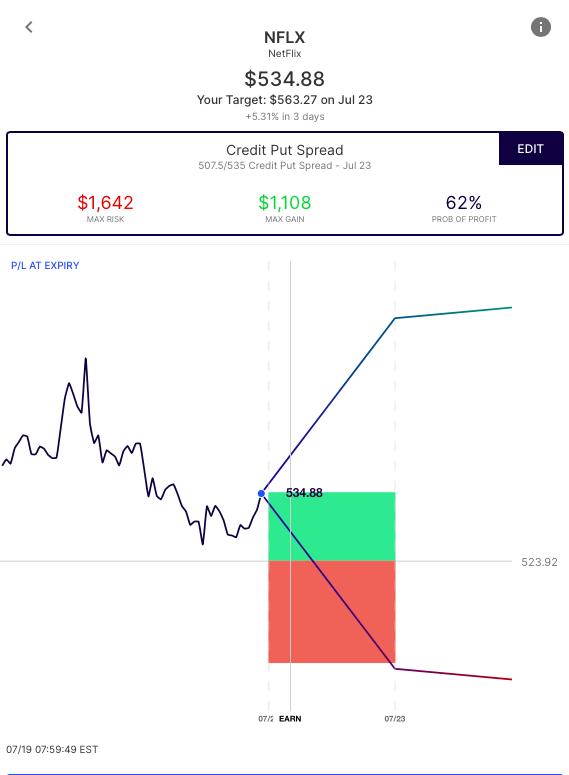
The Credit Put Spread has a breakeven in the stock above $524. In other words, for it to profit, the stock doesn’t necessarily need to go higher, it simply can’t go lower, below its breakeven. The move below $524 is what the buyer of the spread is rooting for. The seller is rooting for it to stay above that level.
Options AI puts the expected move, break-evens, and easy-to-understand risk / reward at the center of its chart-based trading. Traders can quickly generate Debit and Credit Spreads based on the expected move, or put together other multi-leg strategies in the context of the expected move. They can quickly compare Credit and Debit spreads to determine the strategy that best expresses their trading view. They can also create strategies to employ regularly over time.
Here’s an example of a strategy that some traders use on a rolling basis – an Iron Condor that uses the expected move to sell the move. It is essentially positioning for the stock to stay within a range and to not have moved outside of the expected move at expiry:
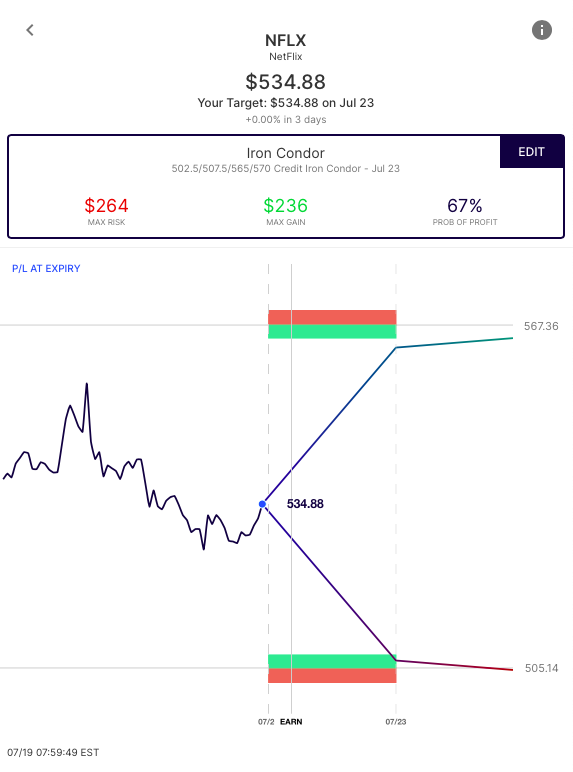
The chart above helps illustrate how the Iron Condor works. It combines both an out of of the money credit call spread, and an out-of-the-money credit put spread to establish a range.
It risks $2.64 to make up to $2.36. It would collect its entire credit received (of both credit spreads) if the stock is between $507.50 and $565 at expiration.
The risk (or max loss), is not the combined max loss of each Credit Spread. That’s because the stock can only move in one direction or the other. One spread will be max gain regardless of what happens.
But also note the lower probability of profit of the Iron Condor vs an outright Credit Call or Credit Put Spread. That’s because the stock can move in either direction, beyond the outer strike of either Credit Spread. If the stock does move beyond either spread, that means max loss for the entire trade, because one of the spreads is max loss.
Traders use Iron Condors for several reasons, including selling volatility, but in the case of an earnings play the outcome can often be fairly binary – either Netflix stays within its expected move by Friday, or it doesn’t.
Based upon publicly available information derived from option prices at the time of publishing. Intended for informational and educational purposes only and is not any form of recommendation of a particular security, strategy or to open a brokerage account. Options price data and past performance data should not be construed as being indicative of future results and do not guarantee future results or returns. Options involve risk, including exposing investors to potentially significant losses and are therefore not suitable for all investors. Option spreads involve additional risks that should be fully understood prior to investing. Securities trading is offered through Options AI Financial, LLC a registered broker-dealer.


